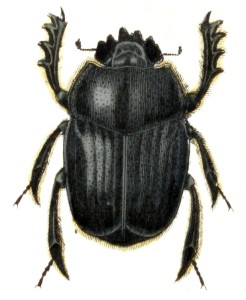 In the beginning the beginning beganIn the becoming the becoming becameI have come into being in the coming of my beingas I came into being in beginning timeTo the ancient Egyptians, the animating force Khepri was best exemplified by the scarab, also known as the Dung Beetle. This little critter descends on the scat of herbivores in droves to consume undigested nutrients. To consume a meal in peace, the scarab pats a piece of dung into a ball and rolls the scat some distance away, sometimes hiding the trophy in an underground niche. The Dung Beetle lays her eggs in concealed dung balls, which the larvae subsist on. The young adult emerges from the dung ball seemingly self-created.By pushing his large dung ball over the sand the scarab illustrated to the Egyptians the force pushing the sun across the sky in the daytime, then pushing the sun under the earth through the night. The scarab was not merely a symbol of this force, named Khepri, but an incarnation of a pervasive presence which manifested through this insect in a pure form.
In the beginning the beginning beganIn the becoming the becoming becameI have come into being in the coming of my beingas I came into being in beginning timeTo the ancient Egyptians, the animating force Khepri was best exemplified by the scarab, also known as the Dung Beetle. This little critter descends on the scat of herbivores in droves to consume undigested nutrients. To consume a meal in peace, the scarab pats a piece of dung into a ball and rolls the scat some distance away, sometimes hiding the trophy in an underground niche. The Dung Beetle lays her eggs in concealed dung balls, which the larvae subsist on. The young adult emerges from the dung ball seemingly self-created.By pushing his large dung ball over the sand the scarab illustrated to the Egyptians the force pushing the sun across the sky in the daytime, then pushing the sun under the earth through the night. The scarab was not merely a symbol of this force, named Khepri, but an incarnation of a pervasive presence which manifested through this insect in a pure form.
Kheper-i kheper kheperu kheper-kuy n kheperu m khepra kheperu m sep tepy.
I first heard this in 1987 at the Isis Oasis in Geyserville, California and it has always stayed with me. More information can be found in a book called Eternal Egypt: Ancient Rituals for a Modern World by Richard J. Reidy and at the website for a group called House of Keperu.
